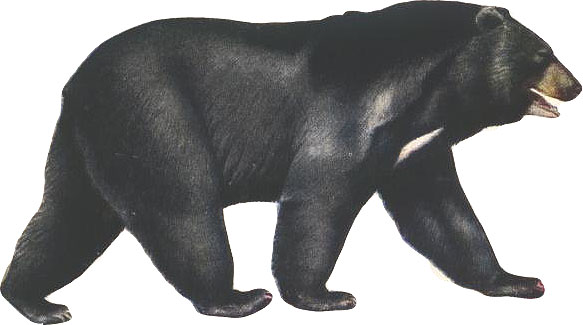|
|
The
Himalayan Black Bear Selenarctos thibetanus
Its
shorter smoother and black claws distinguish it at once from
the Sloth bear. Its build is less clumsy and more compact. General
colour typically black; muzzle, tan or brown; chin, white or
buff: very characteristic is the V shaped breast mark, which
may be white, yellow, or buff.

They are distributed along Kashmir, the Himalayas and Assam,
extending eastwards into china and Japan, Southwards into Burma
and the Malay countries, westward into Baluchistan.
Steep forested hills are the favoured habitat of this bear.
In the Himalayas during summer they may be found near the limits
of the tree line 3050 to 3660 Mt. But in winter they come down
to the lower valleys, 1525 Mt. and even lower. In Baluchistan
they have adapted themselves to life in an arid environment.
The Himalayan black bear spends the day sleeping in a rock cave
or in the hallow of a tree. It comes out at dusk to seek its
food and retires after sunrise. However, it was noted to be
frequently Active during the day in the Dachigam National Park
in Srinagar (Kashmir). Food varies with season in summer they
live largely on wild fruit and berries. Being expert climbers
much of their food is taken from the tree tops. This is season
when honey is to be had. The bear work hard to get at the comb
of the little bee which builds its hive in hallow tree trunks.
It is the most carnivorous of the bears, and many living near
villages kill sheep and goat and even larger cattle. Many people
are killed or mauled by these animals.
The mating season is late autumn. The cubs are produced in the
winter and early in spring, in the shelter of thick under growth
or in a cave or hollow tree. The young, usually two or more,
remain with their mother for a year or more.
Return
to Top
|


